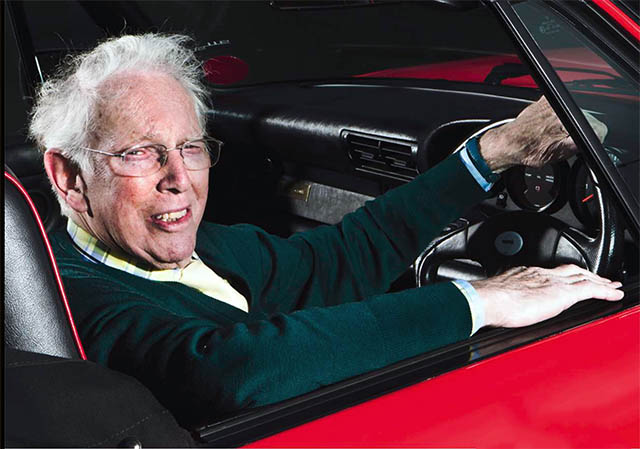
My life in cars. I have always adored the internal combustion engine and everything that goes with it. John behind the wheel of a Porsche 911SC. He wishes that another 911 had played more of a part in his life. Known affectionately as ‘Smokin’ John Rhodes for burning out set after set of Mini tyres, the 86-year-old race legend recalls the many exciting cars in his life. Words: MIKE TAYLOR Photography: RORY GAME/ARCHIVE.
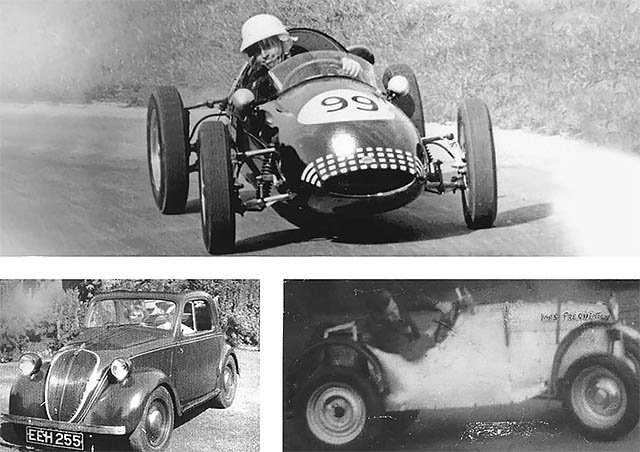
A modest Fiat 500 Topolino whetted John’s appetite for fast(ish) driving. Home-built special created from an Austin Seven bought for £10. ‘It certainly taught you how to drive!’
John Rhodes didn’t have long to wait for his life in cars to get under way in earnest. He was just 11 years old when, in 1938, a trip to the Donington Grand Prix changed his life: the sight, the smell, the noise and the thrill that danger was never far away made an indelible impression on this wide-eyed schoolboy. He wanted to be a part of it.
You could say motor sport was already coursing around his veins when he was born in Wolverhampton in August 1927. His grandfather had been a pioneer motorist and his mother and father campaigned a Standard Flying 12 on events such as the gruelling Land’s End Trial, often returning home with silverware.
Young John’s single-minded ambition stayed with him all through his school years, after which he took up an apprenticeship at a Ford main dealer in the Midlands. He quickly gained the skills to build specials, while membership of Hagley and District Motor Club signalled the start of an illustrious motor racing career that saw him come up against the likes of Bob Gerard, John Cooper, Warwick Banks, Timo Makinen, Paddy Hopkirk and many others.
I have always adored the internal combustion engine and all that goes with it, smiles John, settling into the driver’s seat of Porsche enthusiast Paul Chare’s immaculate Guards Red 911 SC Cabriolet.
In my day the only thing that mattered was the stopwatch. Today, it’s more about the stopwatch and a huge injection of cash.
FIAT 500: THE MOUSE THAT RAISED ITS ROOF
In 1937 my father bought a Fiat 500 Topolino for my mother, my sister and me to share. It was perhaps the smallest real car on the market, with a water-cooled 569cc engine with the radiator at the rear of the engine bay. Power was only 13bhp, so it couldn’t do much more than 50mph.
‘Acceleration was pretty pedestrian too, but I recall a memorable visit to Scotland when the fabulous folding canvas roof made it seem more like driving a miniature sports car. As for the handling, no wonder John Cooper used the Fiat’s transverse semi- elliptic leaf-spring suspension for his 500cc Formula Juniors racing cars.’
A PASSION FOR SPECIALS
‘It was the great Enzo Ferrari who once called the UK “a country of garagistes’ referring cynically to the number of backstreet FI teams during the Fifties and Sixties toiling away to build racing cars. At the economy end of the market, enthusiasts used pre-war Austin Sevens as the basis for specials. Then allegiance changed to the E93A Ford Popular with its larger chassis dimensions and bigger 1172cc engine. Companies like Aquaplane and Elva were soon offering aluminium cylinder heads with twin carburettors to increase power quite dramatically.
‘During the Fifties I bought many Austin Sevens from Bill Butler, a local car breaker, never paying more than £10. I’d remove the bodywork and make it a lightweight two-seater with no brakes and a clutch like a switch – it certainly taught you how to drive! One in particular was based on a stretched Austin Seven chassis with a Morris Eight back axle, an MG gearbox and a Shorrock supercharged Ford engine.
‘My success with cars like that in events organised by the Hagley and District Light Car Club led to a great friendship with Julian Threlfall. Later Julian gave me his crashed Lotus Mkll, which he had somersaulted at the Francorchamps circuit in Belgium. I repaired it and it became my road car. It was a beautiful little machine with a super sleek body designed by Frank Costin, taking me in great style to my racing fixtures.’
SINGLE-SEAT SUCCESS
‘My career in single-seater racing began in 1960, the class running until 1963 as the forerunner to F3 featuring one-litre and 1.1-litre engines. My great friendship with Alan Evans led to him buying a Cooper Formula Junior in kit form for me to build and share the driving. But, faced with the prospect of other cars sharing the track, Alan was happy just for me to take the wheel. This resulted in winning a Formula Junior record at Prescott Hillclimb and a test drive in Ken Tyrrell’s works Formula Junior Team. Then Alan helped to form the Midland Racing Partnership and I had my first links with John Cooper and the Cooper Car Company in Surrey.
In 1961 I built three Formula Juniors with Denny Hulme – who became F1 world champion in 1967 – using the Cooper workshops. Driving the MRP BMC-engined car, I won at Linton-on-Ouse and Mallory Park as well as picking up three more podium finishes that year followed by winning the F1 Championship the following year at Mallory Park.
‘My links with Bob Gerard had begun in 1962 driving his Cooper T59 in two Formula Libre all-comer races, wining both events at Mallory Park. Moving up from driving a Formula Junior car to an FI car was just like driving a grown-up version of the same car. Greater power and control of the throttle made it far more exciting than the smaller racer. I also drove this car in a non-championship F1 race at Silverstone where I finished 13th.
‘My connection with Gerard led to campaigning a Cooper T60 at Mallory Park in another Formula Libre event in which I finished fourth. Using this car with a 1.5-litre Climax V8, I drove in the World Championship round in 1965 at Silverstone. Sadly, the car was hopelessly outclassed and finally succumbed to ignition problems.’
THE ONE THAT GOT AWAY
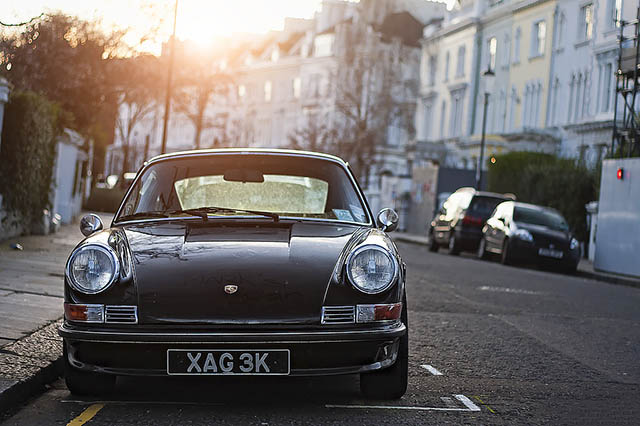
‘Of all the cars I’ve driven I’d love to have owned a John Rhodes Porsche 911S [below John Rhodes]. I recall a spirited drive from Wolverhampton to Bournemouth in a friend’s wife’s 911 to collect his new Porsche. Then followed an even more spirited dice on the way home, which showed the characteristics of the 911S to the full. During hard acceleration the rear end sank lower and the front rose up with constant feedback from the steering, wriggling to follow the road surface. Then on tight bends the front wheel lifted slightly. And all accompanied by that wonderful sound of the flat-six engine. In 1978 the friend offered me the 911S for £4000. Today it would cost £80,000. ‘Ah well.’
MINIS MAKETH THE MAN
‘I perfected my smokin’ Mini style of cornering by always ensuring the back end was purposely light so that I would lose the car. I’d have one hand on the wheel, the other keeping my elbow locked into the open door pocket. I managed to destroy the dipswitch during every race with my left foot wedged in tight.
I was delighted to be invited to drive for John Cooper’s works Mini team, with whom I won the 1300cc Class B in the British Touring Car Championship in 1965, ’66, ’67 and ’68. I loved my time in John Cooper’s team, which was managed to perfection by Ginger Devlin. I also had success with the fabulous British Vita racing team, which was managed with great patience by Brian Gillibrand.
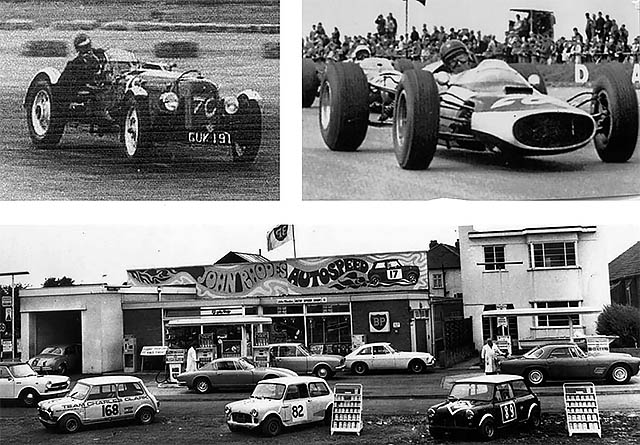
John in action in a supercharged Ford Special at Silverstone in the Fifties. Ignition gremlins put John’s Cooper-Climax T60 out of the 1965 British Grand Prix. John’s Maserati 3500 (far right) and Austin 1800 (far left) outside his garage in the late Sixties. Appropriately, he’s chosen Minis to line the roadside and to feature on that far-out frontage.
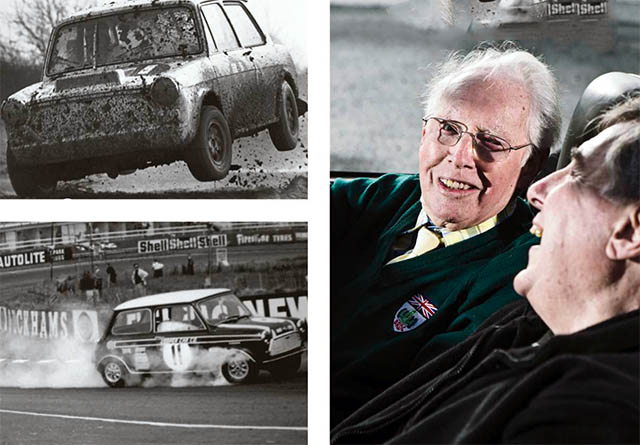
John doesn’t drive now, but his enthusiasm still shines through when he reminisces. Typically spirited performance by John in his aluminium-bodied Austin 1300 rallycross car. John justifies his ‘Smokin’ soubriquet in a John Cooper works 1300cc Cooper S.
‘Then Peter Browning, boss of the British Leyland Competitions Department, gave me a 1300cc fuel-injected Mini Cooper S and later a fuel-injected Austin 1300 with an aluminium bodyshell.
‘Campaigning in rallycross you make your own gaps – there are only four laps to win! The windscreen quickly gets covered in mud. A director of Triplex became very interested in the problem and the company made a special screen with two marine-type portholes and rotary wipers. It worked. Then, first time out, Roger Clark’s four-wheel-drive Capri threw up stones that broke the mechanism, leaving me stranded.
‘On another occasion we came together on a corner as I nipped through. I knocked off his wheel and steering rack. Roger crashed out into the bushes. He wasn’t very pleased…’
THINGS GO FURTHER WITH FREE SHELL
‘Towards the end of the Sixties I was able to run my own garage. My road car at the time was a Maserati 3500, which I’d bought through the trade for a good price.
I ran it for two years and it provided swift transport to circuits at home and abroad. However, with its triple Weber carburettors it was always very thirsty. But the generosity of sponsorship from Shell topping up the fuel tank at race tracks meant it wasn’t a problem for it to stay thirsty! The only problem was the very limited steering lock – thinking myself to be immortal in those days, it led to many spins.
‘On one occasion I had a dice in it on the Continent with a Rolls-Royce. In Britain they’re driven more leisurely, but they can be fast and in the end I had to let it go. I finally sold the Maserati for something more sensible.’
A RELIABLE AUSTIN 1800 AND A ROCKING CARAVAN
‘My links with BL enabled me to buy an Austin 1800 at a good price from the factory. The hydrolastic suspension suited the car well and it could be thrown about like a Mini. Daniel Richmond of Downton Engineering fitted a large-valve MGB-type gas-flowed cylinder head and a tuned exhaust system. Then came Minilite wheels and lowered suspension. Mine had a black vinyl roof on a white car. Painting the grille and sills matt black meant the car looked really mean. I enjoyed 140,000 trouble-free miles. In fact, at every 10,000 miles I’d celebrate by opening a bottle of champagne!
‘To save on hotel bills I bought a caravan to tow behind the 1800, only to suffer disturbed nights’ sleep as friends rocked it vigorously when it was parked at race tracks, completely ignoring the conspicuous Do Not Disturb notice.’
GOODWOOD REVIVAL AND FAREWELL TO DRIVING
‘When out of the blue Lord March restored his Goodwood racetrack I was extremely flattered to be invited to the press day for the first Goodwood Revival in 1998.
‘For many years thereafter I took part, competing in other owners’ cars. Although I’ve been lucky enough to achieve awards in the past, nothing can compare to winning Driver of the Day in Lionel Dodkin’s Mini Cooper S in 1999. To be presented by Lord March with a very large bottle of Veuve Clicquot champagne and a beautiful silver award at 72 years of age -that says it all!
‘Sadly, in 2006 while driving Lord Inchiquin’s Mini Cooper S at Brands Hatch I was punted off into the barriers along Cooper Straight, destroying the car. Ever since then, I’ve been unable to drive because of the injuries I sustained.’
Thanks to John and Jean Rhodes; Paul Chare; Clare Matthews of the Oaken Arms, Codsall, West Midlands





